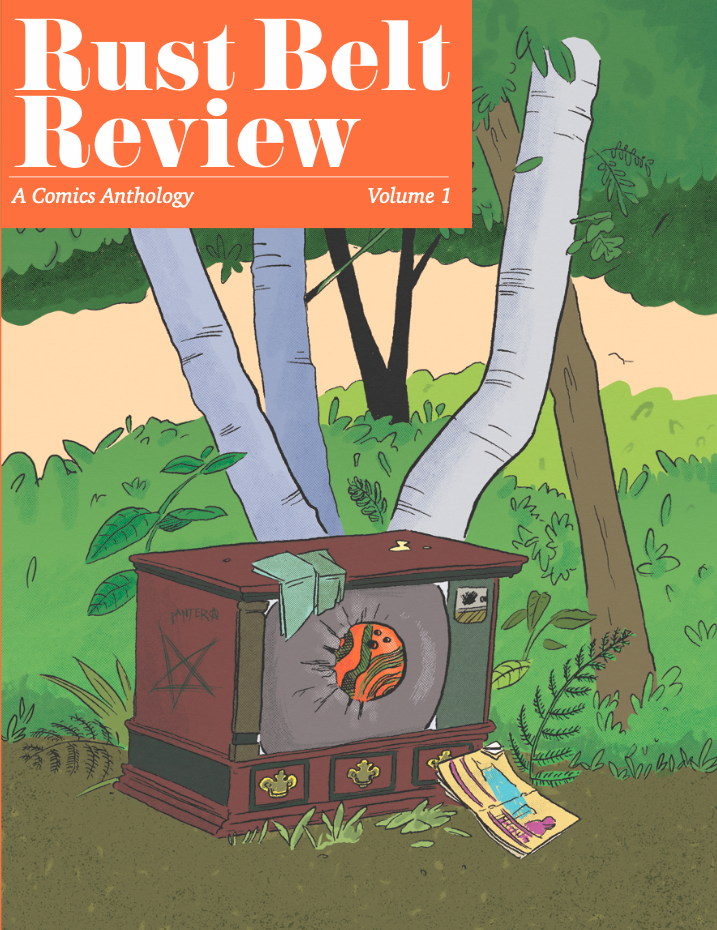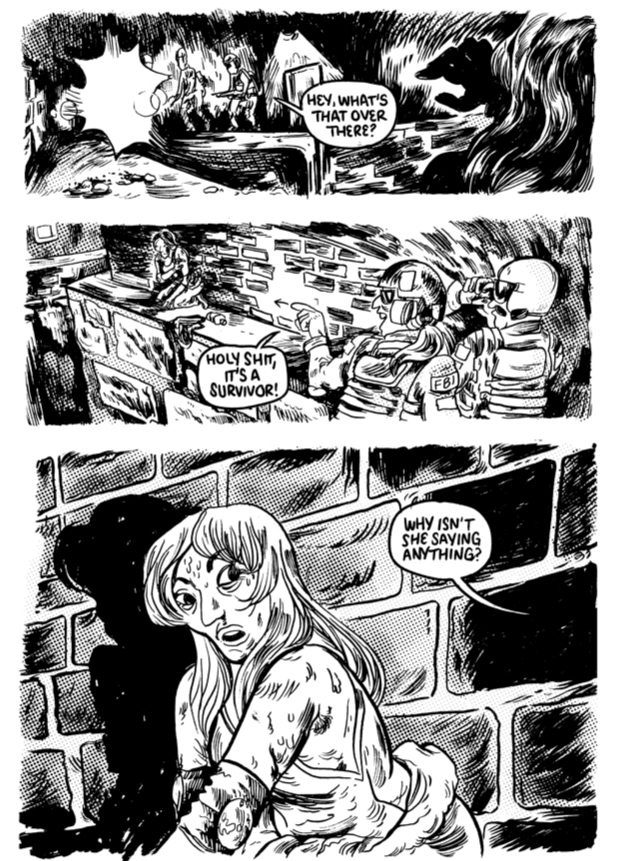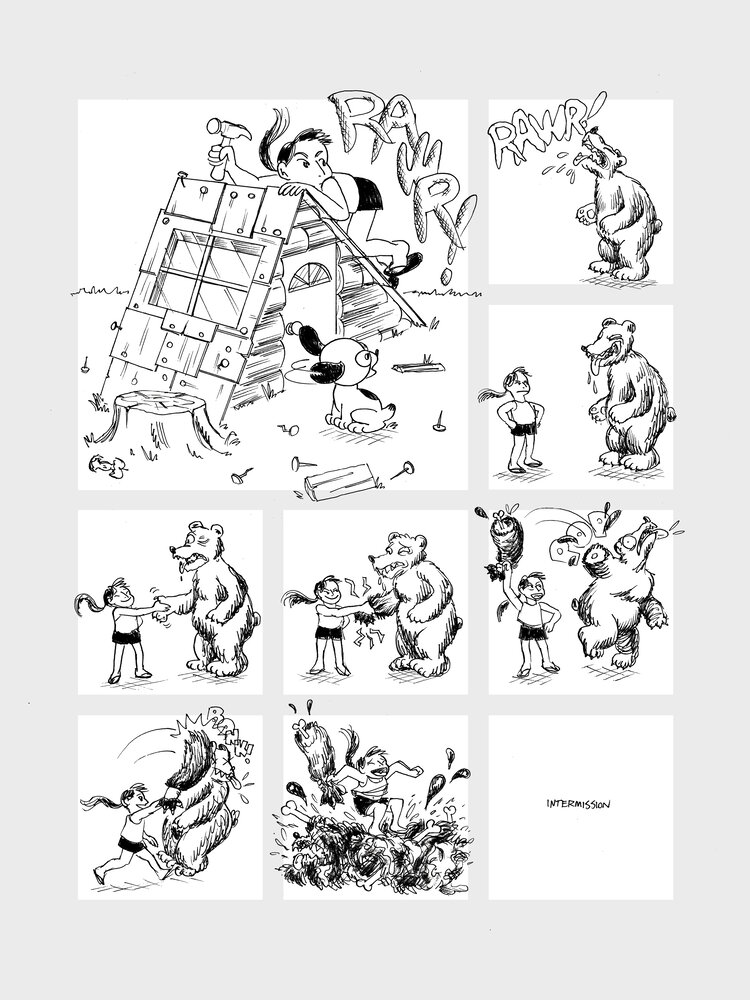In March of this year, Minneapolis-based cartoonist, illustrator, and printer Sean Knickerbocker published the first issue of a new comics magazine, Rust Belt Review, which features serialized works and one-off stories from Juan Jose Fenandez, Andrew Greenstone, MS Harkness, Caleb Orecchio, Audra Stang, and Knicerbocker himself.
Consisting of 72 black and white pages in a 9” by 12” format, Rust Belt Review is, according to Knickerbocker, “a venue for cartoonist making independent work in the small press comics community”. For the inaugural issue, Knickerbocker features artists with whom he has a personal connection. The resulting magazine is another place for cartoonists to get their work seen by a larger audience. Thanks to a global pandemic, traditional venues for cartoonists to show their work have been sidelined. Rust Belt Review was produced to address this issue, as well as attend to some systemic concerns that Knickerbocker has identified that prohibit a wider success for working cartoonists.
Sean Knickerbocker was kind enough to answer a few email questions about his motivations, his plans, and his hopes for the future of Rust Belt Review.

Sean, for readers who aren’t familiar with your work or the work of your collaborators on this project, could you explain Rust Belt Review and your goals for the project?
Sure. Rust Belt Review is a comics anthology series that focuses on publishing short-form and serialized fiction comics. The series draws influences from past anthologies such as Raw Magazine, Mome, and Rubber Blanket. My goal is to provide a space for alternative cartoonists to showcase their work on a more regular basis while also providing a more reader-friendly venue than online spaces.
What’s your publishing schedule for Rust Belt Review looking like? Is this going to be something you are publishing quarterly, or less frequently?
This first iteration is going to be quarterly. Future versions may look different. Depending on how the series is received, I may switch up the model once all of the serialized pieces are finished. I think publishing is going to see a lot of really big changes over the next few years, so it’s important to stay nimble.
In your introduction to Rust Belt Review #1, you state that you would like “to provide a venue for cartoonists making independent work in the small press comics community”. I gather from this that you identified barriers to entry to existing anthologies and/or venues. Is that true?
I think the biggest barrier in most contemporary anthologies is the adherence to a specific theme, or the inability to present serialized work over a number of issues. I want a comics anthology that is more like a literary journal. I think this allows for more flexibility for the contributors to work on larger projects while also engaging with their readers and the comics community on a regular basis. Ideally, I would like to see a number of these magazines existing. I’m certainly not the arbiter of “comics craft”, I would like to see other people’s tastes out there as well.

When you say you want to create a space for creators to publish ongoing stories, it seems like you are specifically referencing the other major “literary magazine anthology” – Fantagraphics’ NOW. What do you think separates what you are doing from what they are doing?
I think NOW has a much wider range of work, and it’s a little all over the place. I’m trying to create a magazine that’s a bit more cohesive. Partly due to my budget and partly my own tastes, I’m focusing exclusively on black & white comics, and they are largely driven by narrative. There is some room for more experimental work, but I would like to reserve that space for pieces that read more as a visual essay and less as a noise rock guitar solo, if that makes sense.
One other major anthology series that comes to mind as a “literary” magazine is Cold Cube Press’ Cold Cube Anthology, which includes poetry and short stories. Have you considered other material for Rust Belt Review besides comics?
For the time being, I want to focus mainly on the comics community. I would like to include some writing in future issues, but mainly comics criticism, or some helpful DIY tutorial-type stuff. I want to be a resource for cartoonists.
My wife is actually working on a lit mag with some friends, it’s called Lost Pilots. If anybody has some poetry they would like to submit, check them out at lostpilotslit.com. I fantasize of teaming up with them on a one-shot special sometime, but we’ll see.
In your introduction, you also note some concerns with comics festivals, that these shows aren’t sustainable for the cartoonists tabling at them. You cite the expenses associated with travel, print, and table costs as the main reasons for this unsustainability. Can you expand on this a little?
I should start off by saying that I really do appreciate all of the hard work that volunteers and organizers put into comics festivals, and I think they are a critical pillar to the community.
I’ve gone through periods of my life where I was living in the middle of nowhere, and I couldn’t afford to engage with the community more than once a year at the most. Making comics can be very isolating, and doubly so if you’re making comics that have no formal distribution method. With that thought, I started to think about any number of issues that could prevent somebody from not being able to participate, be it financial, social, or medical in nature. I’ve seen so many cartoonists disappear from the community for one reason or another, and I can’t help but think that maybe some of them would still be around if there was a space that was more accessible for them.
How does a project like Rust Belt Review address some of these issues?
The magazine allows for creators to release their work on a regular basis without having to attend a convention or commit to self-publishing their work. Both of these things can be major costs when it comes to engaging with our audiences regularly. I’ve always liked the built-in deadline for a show, so I thought keeping a magazine on a regular publishing schedule would help keep myself and others on track.
I’ve designed the magazine to operate profitably even at low print runs, nobody is getting rich off of this, but I want to provide a meaningful supplemental income for my contributors. As of right now, I’ve mostly reached out to close friends because of this. Of course, if there is somebody interested in contributing, I invite them to send me a pitch at therustbeltreview@gmail.com along with a sample of their work.
A lot of anthologies pay their cartoonists a page rate or a rate for a specific story. Is Rust Belt Review built on that same platform, or do artists get a royalty?
Right now, I’m paying folks with royalties and contributor copies. One of my long-term goals is to be able to provide a page rate for contributors. I’m hoping this will be possible in the near future. I’ve been hesitant to reach out to artists outside of my circle because of this. My mission is to provide a venue to the comics community as a whole, so I think it’s critical to get to a point where I can solicit work from people outside of my circle while also being able to pay them for their work.

Putting together this anthology semi-regularly is asking a lot of you in addition to your normal cartooning practice. How do you make Rust Belt Review sustainable in the long term?
I’ve been wrestling with a lot of these issues for about a decade now. I don’t know why, but I’ve always been interested in figuring out the best way to make a small press series sustainable. I’ve optimized a few of the key processes for Rust Belt Review including design, fulfillment, and promotion.
The series intentionally has a minimal aesthetic. I looked at a few ongoing lit journals for inspiration. I found that most of them relied on very simple layouts to accommodate a wide range of work while also maintaining a sense of unity. Of course, with comics being a visual medium, this can be a little bit more difficult, but I felt it was important to create a book that would act primarily as an invisible vessel for the work held within its pages. Because of the design, the layout work wasn’t too difficult. I have a background in print production, so layout and design work doesn’t demand too much of my time.
I work for a company that does book printing and fulfillment, so I observed some of the procedures that other publishers have used and applied them to my own print productions and print orders. I can now easily monitor my sales, place conservative reprint runs that don’t break the bank, and fulfill online orders within minutes.
It’s been a fun little challenge to try to create such a series. I look forward to growing this magazine and offering a new resource for cartoonists and readers.
What are some challenges you’ve run into thus far? What has been the most enjoyable part of making this anthology? What have you learned from this process?
I think promotion has been a really big challenge for me personally. I hate being a carnival barker. I think if the work is good, it will speak for itself. That being said, I have a duty to my contributors to sell this book as hard as I can. I’m learning a bit about online marketing, and I’m trying out a bunch of different methods to see what works and what doesn’t. I cringe every time I post something on my Instagram with a product link, but I try to make sure there’s still plenty of my own personality in the stuff I share online.
I think the most enjoyable part has been seeing the reaction from readers. Whenever I see somebody tag me in a post with a copy of the book, my heart warms a little. I’m really excited to see that I can get those same sorts of warm and fuzzy convention feelings even in a socially distanced world. That gives me hope that maybe this can be a viable model for Rust Belt Review and other publications.
Thanks so much for taking the time to answer these questions, Sean. Is there anything else you’d like us to know about Rust Belt Review that we haven’t covered already?
Thanks for chatting with me. People can order a copy of Rust Belt Review Volume 1 through my online store. You can expect to see Volume 2 in June. I’m already seeing work roll in for Volume 2 and it’s really great, I can’t wait to share it with folks.
SOLRAD is made possible by the generous donations of readers like you. Support our Patreon campaign, or make a tax-deductible donation to our publisher, Fieldmouse Press, today.

Leave a Reply